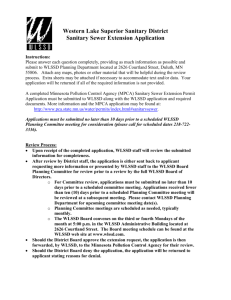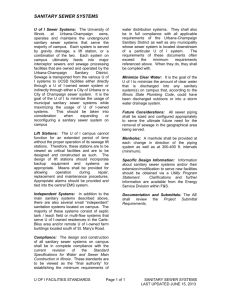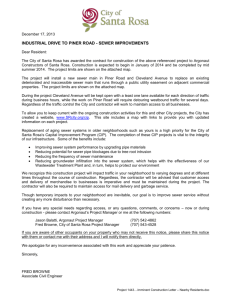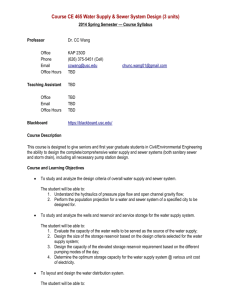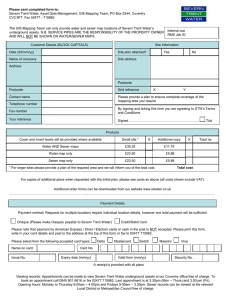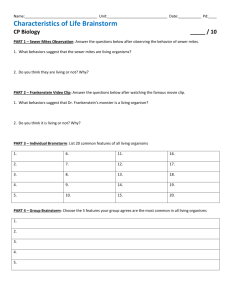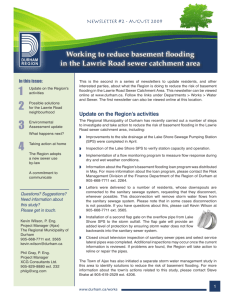Sanitary Sewer - League of Minnesota Cities
advertisement
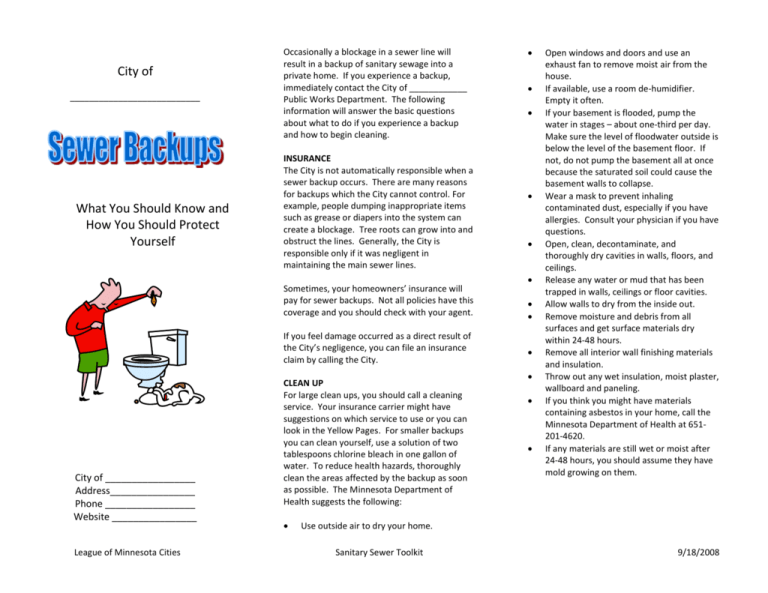
City of ___________________________ What You Should Know and How You Should Protect Yourself Occasionally a blockage in a sewer line will result in a backup of sanitary sewage into a private home. If you experience a backup, immediately contact the City of ____________ Public Works Department. The following information will answer the basic questions about what to do if you experience a backup and how to begin cleaning. INSURANCE The City is not automatically responsible when a sewer backup occurs. There are many reasons for backups which the City cannot control. For example, people dumping inappropriate items such as grease or diapers into the system can create a blockage. Tree roots can grow into and obstruct the lines. Generally, the City is responsible only if it was negligent in maintaining the main sewer lines. Sometimes, your homeowners’ insurance will pay for sewer backups. Not all policies have this coverage and you should check with your agent. If you feel damage occurred as a direct result of the City’s negligence, you can file an insurance claim by calling the City. City of _________________ Address________________ Phone _________________ Website ________________ League of Minnesota Cities CLEAN UP For large clean ups, you should call a cleaning service. Your insurance carrier might have suggestions on which service to use or you can look in the Yellow Pages. For smaller backups you can clean yourself, use a solution of two tablespoons chlorine bleach in one gallon of water. To reduce health hazards, thoroughly clean the areas affected by the backup as soon as possible. The Minnesota Department of Health suggests the following: Open windows and doors and use an exhaust fan to remove moist air from the house. If available, use a room de-humidifier. Empty it often. If your basement is flooded, pump the water in stages – about one-third per day. Make sure the level of floodwater outside is below the level of the basement floor. If not, do not pump the basement all at once because the saturated soil could cause the basement walls to collapse. Wear a mask to prevent inhaling contaminated dust, especially if you have allergies. Consult your physician if you have questions. Open, clean, decontaminate, and thoroughly dry cavities in walls, floors, and ceilings. Release any water or mud that has been trapped in walls, ceilings or floor cavities. Allow walls to dry from the inside out. Remove moisture and debris from all surfaces and get surface materials dry within 24-48 hours. Remove all interior wall finishing materials and insulation. Throw out any wet insulation, moist plaster, wallboard and paneling. If you think you might have materials containing asbestos in your home, call the Minnesota Department of Health at 651201-4620. If any materials are still wet or moist after 24-48 hours, you should assume they have mold growing on them. Use outside air to dry your home. Sanitary Sewer Toolkit 9/18/2008 FOOD Throw out any opened food or packaged foods that are not waterproof. Commercially canned foods can be salvaged if the labels are removed and the cans thoroughly washed. The cans should be disinfected by wiping the entire surface with a laundry bleach and water mixture and rinsed in clear water. Home-canned foods require additional care. After the jars containing home-canned foods have been washed and disinfected, the jars should be boiled for ten minutes before using. WET FLOORS OF HARDWOOD Remove all moisture or debris. Scrub floors and woodwork within 48 hours using a stiff brush, water, detergent, and disinfectant. Allow all wood to dry thoroughly. CLOTHING/HOUSEHOLD Line-dry all articles before attempting to clean or treat them. After drying, brush off loose dirt and debris. Send “Dry Clean Only” items to a professional cleaner. Wash clothes several times in cold water. Add up to a cup of bleach per load of wash if it will not harm the clothing. Rinse and dry all items as soon as possible. Throw out mattresses and pillows. WET APPLIANCES If your hot water heater became wet due to flooding, it should be discarded. The insulation typically can’t be replaced and the burner or heating element might become damaged and could cause an explosion or fire if used. If in doubt consult a service professional before using. If the furnace was flooded, have it inspected and serviced by a professional furnace service before using. WET CARPETING Pull up waterlogged carpet immediately to prevent further floor damage. Carpet pads cannot be saved. Remove the pads and throw them away. Attempt to save carpets or throw rugs only if they would be very expensive to replace. Clean and dry your floors thoroughly before re-carpeting. RECORD KEEPING Take pictures of damage for your records. Keep all receipts for all work done. Write a description of the extent of damage. Record date and time of occurrence and note which sewer areas surcharged– floor drain, lower level toilet, laundry tub and the like. League of Minnesota Cities WET FURNITURE Discard upholstered furniture if it has been exposed to water or contaminated material. Clean, rinse and disinfect wood furniture. Place wood furniture outside in a shady area so it will dry slowly. Sanitary Sewer Toolkit HELP PREVENT BACKUPS The following items should be disposed of in your trash can, NOT in the sanitary sewer system: Diapers Paper towels Cooking grease Food (do NOT use the disposal for all food items) REMINDER Property owners are responsible for the maintenance, repair, and cleaning of the service line from the house to the City main line. FOR MORE INFORMATION For more information, contact the City of _________________ Public Works Department at _______________ or visit the city’s website at _________________________. For more information on clean ups, visit the Minnesota Department of Health’s website at www.health.state.mn.us 9/18/2008
